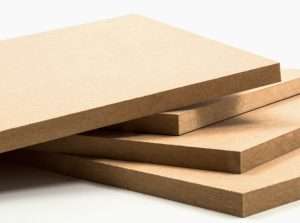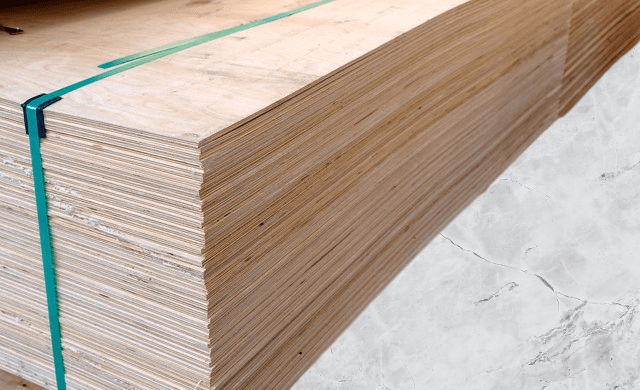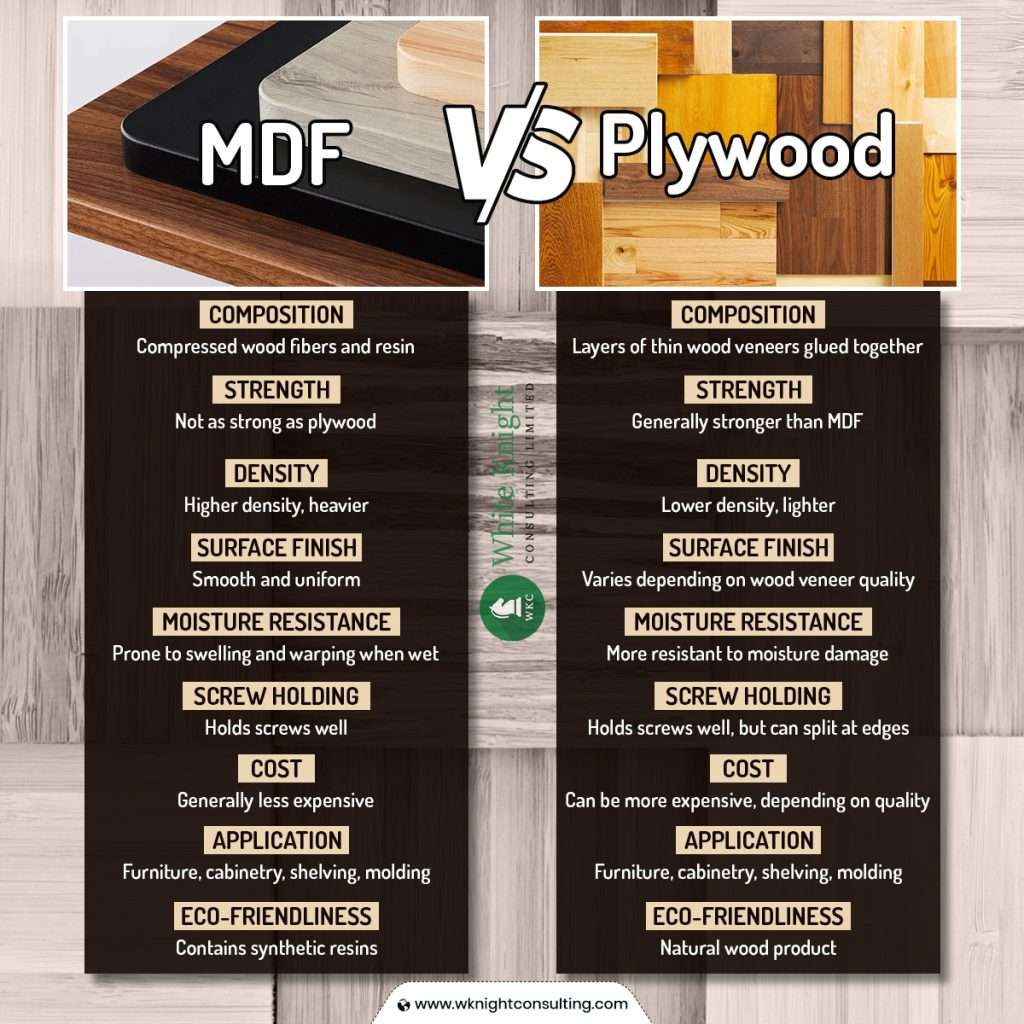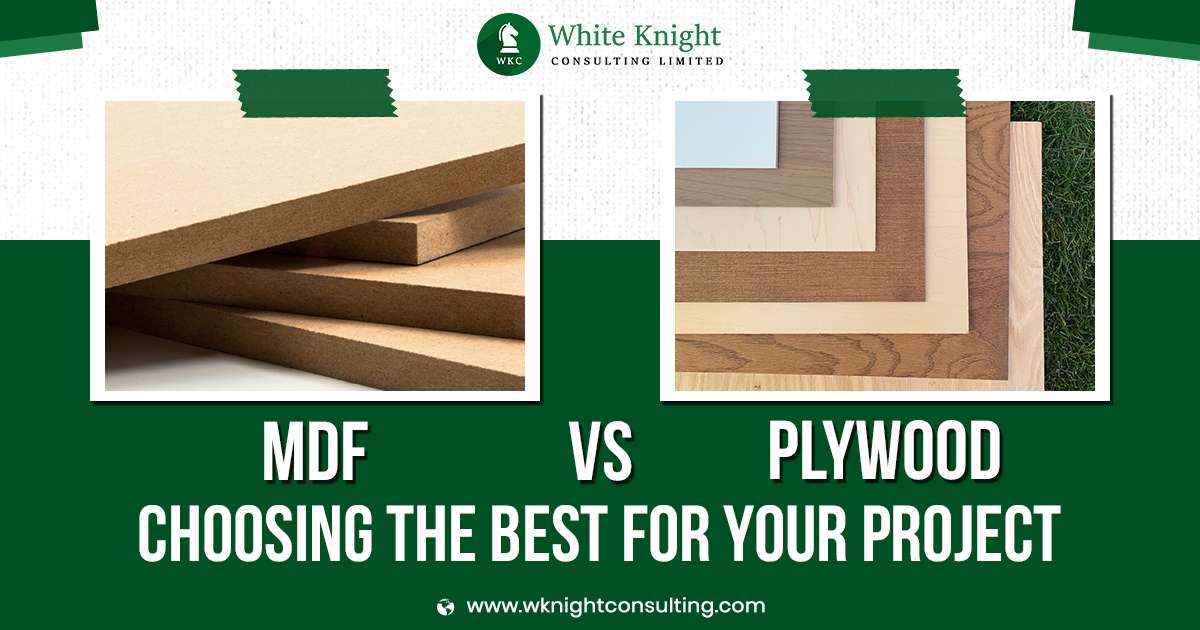MDF (medium-density Fiberboard) and plywood are two of the most popular manufactured wood options. There are various differences and a few similarities between MDF and plywood.
MDF is lightweight, softer and cheaper than plywood. It cannot take heavy loads but is suitable for lightweight applications such as cabinetry and for making shelves. Plywood is considered one of the best alternatives to solid wood because of its high strength and durability. It is hard, strong and can be used for heavy-duty applications such as construction, furniture, flooring, etc.
What is MDF?

MDF stands for medium-density fiberboard, which is a type of engineered wood product. It is produced by breaking down hardwood or softwood residuals into wood fibres and then combining them into solid wooden boards using a synthetic resin binder (glue). Wood fibre-resin mixtures are moulded into panels or boards of different sizes using specific high temperature and pressure conditions.
It is popular as a cheaper alternative to plywood and other types of engineered wood. It is particularly favoured for manufacturing lightweight furniture, cabinetry, shelves, and a variety of other interior applications. However, MDF has its cons. It is not waterproof and absorbs moisture very quickly, which is why it is not suitable for outdoor use.
Apart from its affordability, medium density fibreboard (MDF) is also prized for its versatility, as it can be used in many applications, including modular furniture, and it is also easy to machine, shape and paint to suit different requirements or projects. Also, medium density fiberboard is a popular choice for DIY projects and professional carpentry alike.
What is Plywood?

Plywood is the most popular and strongest of all engineered woods. It is made by combining thin layers or veneers of solid wood. Veneers are glued together such that adjacent wood layers have their grain at right angles to each other in order to give it more strength and dimensional stability, which is particularly important for construction use. Strong adhesives are used to bind the veneers, and the boards are processed through high pressure-temperature to form solid, strong panels.
It can be made in various thicknesses and grades, which differ in terms of strength and durability. The different types of plywood may have different core layers or veneers (extracted from different wood species). The better the veneer quality, the better the formaldehyde-free plywood.
It is commonly used in construction, furniture making, flooring, cabinetry, and many other applications as an alternative to solid wood. Plywood can be easier to work with than real wood and is also often cheaper and better in terms of strength and durability.
MDF vs Plywood

Plywood is better than medium density fiberboard in terms of overall quality, strength and durability.
The advantages of plywood over MDF include higher strength, durability, resistance to cracking under pressure, and its ability to hold screws really well. It also looks better than MDF, which may have wood fibres appearing on its surface. Framing with plywood is more expensive than MDF but generally cheaper than real wood.
MDF vs Plywood : Which is Better?
Structure
Medium-density fiberboard is made by using wood fibres, which are combined together using wax and resin and heat pressed to form long, solid boards. MDFs have smooth surfaces with a uniform and free of knots structure, making them a popular choice for furniture and cabinetry.
Plywood is made from thin layers of solid wood called veneers, which are obtained from wood logs, cut into the desired shape, layered and glued together using powerful adhesives and then pressure-heated to form strong boards. It has veneers combined together at right angles to each other to enhance strength. Face veneers (top & bottom) are higher grade than inside plies.
Appearance
MDF has a uniform, smooth surface with grain not clearly visible. It is good to look at and can be used without painting or staining. However, it is commonly veneered or painted to enhance its appearance, especially when used in furniture or home interiors. Medium density fiberboard is ideal for experimenting with a wide range of design or colour options.
Plywood reveals the natural grain pattern of its solid wood layers, which means it looks similar to real wood and offers a visually appealing texture with interesting grain patterns just like actual wood. This look can be further enhanced with clear finishes that help to protect against damage from fine particles. The plywood needs not to be painted but is often attached with a decorative laminated layer like sunmica when used in furniture.
Strength
MDF is not very strong. It is also not inherently resistant to water but can be manufactured in a water-resistant form also. It is dense but less strong than regular plywood. MDF is also less stable and can easily crack or split under heavy loads.
Plywood is the best option for those looking for a very strong and somewhat durable material. Waterproof and fireproof plywoods are also available. It comes in many grades, ranging from moderately strong to extremely strong and durable, including higher grades of plywood. It is generally stronger than MDF. This is because it is manufactured using multiple layers of thin wood veneers which are joined together in a cross-grain pattern for excellent strength and stability.
Plywood is suitable for applications where higher strength is required, such as construction and strong furniture, while medium-density fiberboard is mostly used for decorative purposes.
Workability
Medium-density boards are very easy to work with. They can be machined, painted and stained easily to achieve the desired look for a project. Because MDF is softer, it is generally more prone to chipping. Also, it doesn’t hold screws or nails really well. It also absorbs moisture really fast, which can cause MDF to swell and damage.
Plywood is also fairly easy to work similar to many solid woods. It can be easily cut, shaped, drilled, and nailed without much splintering or chipping. Due to its solid structure, it holds screws and nails very well and is ideal for joinery applications.
Safety Risks
Both plywood and MDF may involve the use of urea-formaldehyde and phenol-formaldehyde resin, which in very high concentrations can be carcinogenic (responsible for cancer). However, the possibility of cancer due to plywood or MDF is extremely low.
MDF vs Plywood : Availability & Price
Plywood is more popular and widely available compared to MDF. As one of the most popular construction and woodworking materials, it is manufactured in various sizes and comes in many grades. It can be easily found at most home improvement stores and online wood websites.
MDF is also quite popular for interior and decorative uses. It is manufactured in various sizes and is as easily available as plywood, though its availability might be limited in some areas.
As for price, medium-density fiberboard is generally less expensive than plywood. This is because MDF is made from wood residue and resin. Plywood, on the other hand, can be pricey because it involves the use of multiple layers of solid wood layers. The cost of the two entities can also vary depending on various factors including the thickness, quality, and demand.
MDF vs Plywood : Uses
MDF is mainly used for interior applications, including making cabinets, shelves, crafts, decorative items, mouldings, and trim.
Plywood is a versatile wood product with many possible uses. It can be used for furniture, flooring, construction, structural components, walls, sports equipment, musical instruments, boxes, and more.
Plywood is a common solid wood alternative for construction and heavy-duty woodworking due to its high strength and durability. It is commonly used in making structural wood components such as subflooring, roofs, beams, columns, wall sheathing, and formwork. Plywood can take heavy loads. It is also a wonderful choice for furniture making and is used for manufacturing cabinets, boxes, beds, carcasses, drawers, chairs, tabletops, and more. Because it looks naturally beautiful with its visible wood grain, it is also a good choice for decorative uses such as panelling, cabinetry and flooring.
Medium-density fiberboard, on the other hand, is good for interior and non-structural applications. It has a smooth and uniform surface which makes it ideal for use in cabinetry, furniture, shelving, and similar applications. MDF is also considered a good choice for trim applications, including mouldings, baseboards, and window casings. It has a fine texture, which makes MDF easy to paint and finish and suitable for painting applications such as drawing boards. MDF is also used in carving and crafting applications because of its excellent machining properties.
MDF vs Plywood : Which is the Best Engineered Wood?
Both plywood and MDF are popular engineered wood options used in various woodworking applications. Plywood is stronger, more stable and more durable than medium-density fiberboard. It is also easier to work with, nail and screw. However, MDF is less expensive.
While medium-density fiberboard is suitable only for interior applications such as furniture and cabinetry, high-quality plywood can also be used outdoors and for heavy-duty applications such as construction.
Choosing between mdf vs plywood requires careful consideration of factors such as the intended use, desired aesthetic, budget, and specific project requirements. Consulting with a timber wood expert, such as White Knight Consulting LTD, can provide valuable insights and guidance in making the right decision for your project. Their expertise and knowledge of timber products can assist you in selecting the most suitable wood material based on your needs, ensuring optimal results and satisfaction with your woodworking endeavors.
